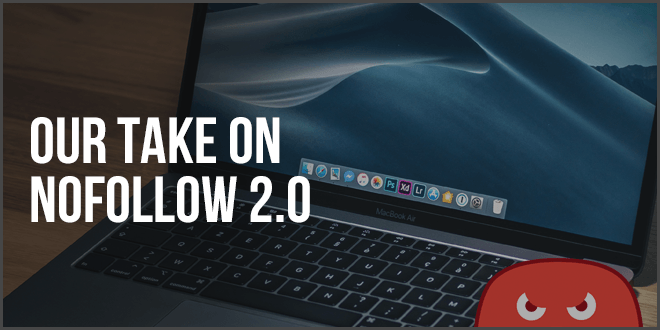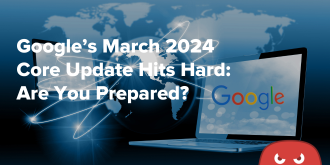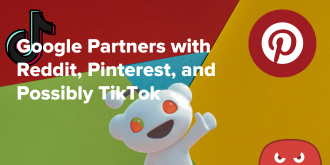Quick Links
Google just introduced new link attributes that may affect the way links are calculated.
SEOs are calling this change “NoFollow 2.0” because it makes changes and gives new more granular options to the nofollow tag.
In this post, I’ll cover what you need to know and what it means for your SEO going forward!
First, What Is NoFollow?
Nofollow is a type of link attribute that tells Google to not give any credit to a link. The opposite is “dofollow.”
In general, getting “dofollow” links are much more powerful than getting nofollow links.
When Google originally introduced the nofollow link attribute, it helped webmasters protect their sites from giving credit to an outbound link when they didn’t want to.
This could be for a number of reasons:
- Comment Spam: By allowing the ability to drop a link when leaving a comment, many link builders would go and leave thousands of comments just to get a link. So by making all comment links nofollow, it discouraged this type of spam.
- Advertising: Say you want to sell advertising on your website and have banner ads that link to the advertiser. In this case, you could mark the links as nofollow, since they are not editorial choices.
In general, you can use the rel=nofollow attribute on any link that you don’t want to give credit to.
These are just examples of when nofollow links came in handy; there are many more.
What Is NoFollow 2.0?
“NoFollow 2.0” is the new name that the industry is using to describe the new link attributes.
There are 2 new types of attributes Google is rolling out:
- rel=UGC: Stands for “user generated content” and can be used any time someone other than the editorial staff of a website is generating content.
- rel=sponsored: This is pretty obvious, but this stands for any time the link has been sponsored or paid for.
- rel=nofollow: This just tells Google to not give any credit to the link. (This is not new).
Why Is Google Making This Change?
In the past, many webmasters would blanket nofollow links, which would tell Google to give the link zero credit.
But in the current ecosystem of the online publishing world, this doesn’t make as much sense anymore, and Google wants to give more ways to more accurately identify the links.
For example, in the past, large publishers would have guest contributors contribute a large amount of content to the site so they could increase their pageviews.
Some of the biggest publishers in the world have gotten into trouble because all the outbound links were dofollow.
So when the publishers got scolded by Google for this, they switched EVERYTHING to nofollow, which may not be the best blanket choice.
With these new updates, Google gives publishers more nuanced ways of categorizing links, and may allow Google to give users better search results by calculating link value more accurately.
What Will Actually Happen?
Just like every update, we’ll have to wait to see some actual data to make any real conclusions.
With that said, there are a few things that we believe will change in the future.
1. Adoption Rate
The biggest question, first of all, is – What will the adoption be?
Even Google says in their official statement that you don’t need to change anything, only if you want to.
The effort involved in changing link types for most publishers / website owners will not be worth the benefit (there isn’t much).
In my opinion, I think that adoption will be very low with the exception of large, SEO-savvy publishers unless some sort of event forces the changes.
There also may be some adoption by CMS changes as well, for instance, if a new version of WordPress comes out that automatically categorized blog comment links as UGC.
But for the majority of the internet, there aren’t many incentives to adopt the new link types vs just keeping things the way they are.
In the case that the new link types ARE adopted, they may affect rankings.
The following could happen:
- Nofollow links: Google may treat these a bit differently going forward. I believe Google already does weigh nofollow links differently depending on related factors (placement, type of site, relevancy etc).
- Sponsored links – Google will likely ignore these links entirely.
- UGC links – Google may give some small credit to these, depending on related factors (placement, type of site, relevancy etc).
Again, we will not know how this changes the landscape for sure until we see some real data on this.
What Should You Do?
Unless you are a publisher, there isn’t much to do here. Again, all of this will depend on the adoption of the new link types for it to affect anything.
1. Keep Building Links
Just as it’s natural currently to have both dofollow and nofollow links in your profile, it will be natural in the future to have all the new link types.
It’s also important to understand that none of the new link types are “bad”.
For example:
- It’s natural to advertise and link to your site (Google makes its own money on selling banner ads and links to sites through its Google Display Network).
- It’s natural to get links by contributing to online publications, commenting on blogs, and posting to forums as user-generated content.
- It’s also natural to get straight nofollow links through creating social media profiles or other methods.
In the future, a natural link profile will contain all of these.
2. Keep An Eye On Rankings
We’ll see how these affect rankings as they roll out, and it may be for the good as Google is able to give more credit where previously nofollow was treated as zero credit.
3. Diversify Your Traffic
I’m a big fan of being a multi-channel marketer. In this case, I don’t believe that this will have a massive impact on SEO (at least not right away), but you should still invest in diversifying your traffic sources.
If you need some help with that, you can check out our new HOTH PPC product!
Conclusion
Google released new link attributes to give publishers more nuanced ways to identify links. The impact of these new types will depend heavily on adoption.
What are you seeing on your end? Let us know in the comments!









Nice post. It is very helpful. I think It’s also natural to get straight nofollow links through creating social media profiles or other methods.
Right, any natural profile will have a mix of all types of links.
When I said I loved theHoth I meant I loved you guys for this kind of content you put up.
I will surely take care of this update on my website.
Thanks for such a nice piece.
You’re welcome!
Kinda hard to say what’s going to happen when this officially rolls out but appreciate the assumptions!
Agreed, we will see!
Good to be aware of this. UGC sounds like a useful, though small contribution to seo rank. Any small improvement helps. May have missed the point, but I did not quite get when this will become effective. Dis Google already implement this?
Also interested to know how you learn about these updates Clayton.
Good job buddy!
This is straight from the Google Official Blog:
All the link attributes, sponsored, ugc and nofollow, now work today as hints for us to incorporate for ranking purposes. For crawling and indexing purposes, nofollow will become a hint as of March 1, 2020.
https://webmasters.googleblog.com/2019/09/evolving-nofollow-new-ways-to-identify.html
Very good insight on these nuances. That means I could proactively invest some more time in getting no-follow links, as it seems to me they should not be underestimated. Thanks a lot for the article!
Well post you have shared with us Thank you! I just want to ask 1 thing that Should i do any changes on my website after this google updates.
No changes are required. Even Google says this is optional for previous links.
Thank for this update, just came to know about the new Google link attribute from this blog. Thanks a lot to share this information with us.
Thanks for the information. I am always looking for new ways to approach the SEO game to better results for my online business. I appreciate you sharing.
Wow! I was not aware of this. Thank you.
Thanks for updating with the latest news from the SEO world. Waiting for the ups and downs due to this new link attributes by Google.
Thanks for another clearly written, easy to understand article!
Thanks for explaining the updates with clarity..
Atleast UGC ensures some credits in future!
Great post – small typo on the word advertising though
Fixed, Thank you!